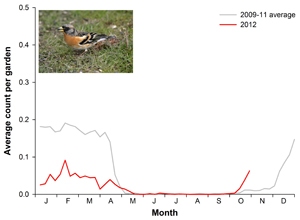A woodland feel to gardens this autumn
Participants in the year-round BTO Garden BirdWatch survey are reporting busy times in gardens this autumn. When considering the 40 or so most frequently-spotted garden birds, overall numbers have been 15% higher this October compared with the previous three. Indeed, over 80% of these species have been more abundant.
Woodland birds have particularly caught the eye. With seed and nut crops in the countryside appearing to be patchy, many woodland species have turned to bird feeders (as have Grey Squirrels). The Garden Ecology Team has heard from many householders over recent weeks who have been enjoying watching Coal Tits busily caching food for the winter. This diminutive bird was up 62% in gardens this October compared with the three-year average. As they busy themselves caching, Coal Tits can become quite approachable – these ones were happy to take seed from the hand of Garden BirdWatcher Catherine Webster in Angus.
Winter visitors to our shores, Bramblings, have also been delighting householders. Numbers of this attractive finch in gardens vary annually depending on levels of immigration and food availability in the UK countryside. Normally Bramblings move more into gardens from mid to late-winter, but this year has seen an unexpected early peak. Is this the start of bigger things to come over the next few weeks, we wonder? Also sweeping onto feeders in larger numbers than normal have been Siskins – their numbers four times higher this October compared with the recent average for this month.
Other seed and nut specialists have been taking advantage of offerings provided by householders. These include Nuthatch (up 90% this October), Jay (up 85%) and Great Spotted Woodpecker (up 66%). These and several other species are known to make greater use of gardens when natural food in the countryside is scarce, BTO research shows. The current influx of birds into gardens hints once again at the vital role that gardens play in the wider foraging environment of many birds.
In parts of the countryside, berries also appear to be thin on the ground this autumn. In gardens, however, birds are able to exploit different fruits and berries owing to the presence of many native and non-native trees and shrubs. These are currently attracting several members of the thrush family – most notably Blackbird, Mistle Thrush, Redwing and Fieldfare – in unusually high numbers. Providing some fruit, such as apples or pears, in your garden will help to cater for these thrushes, and will also help to sustain visitors such as Blackcap.
Read the press release about this story (includes summary table of the top 20 garden 'winners').
Which birds are visiting your garden? Please let us know through Garden BirdWatch. For a free enquiry pack, including a copy of our quarterly magazine for participants, email your name and postal address to gbw [at] bto.org.








Share this page